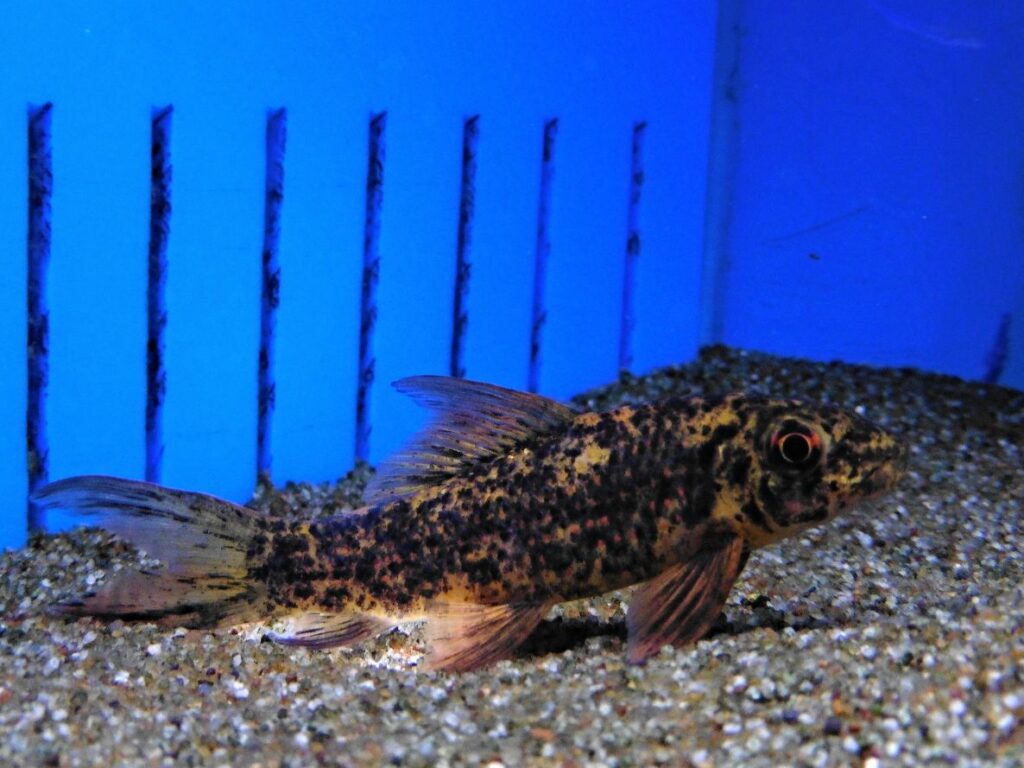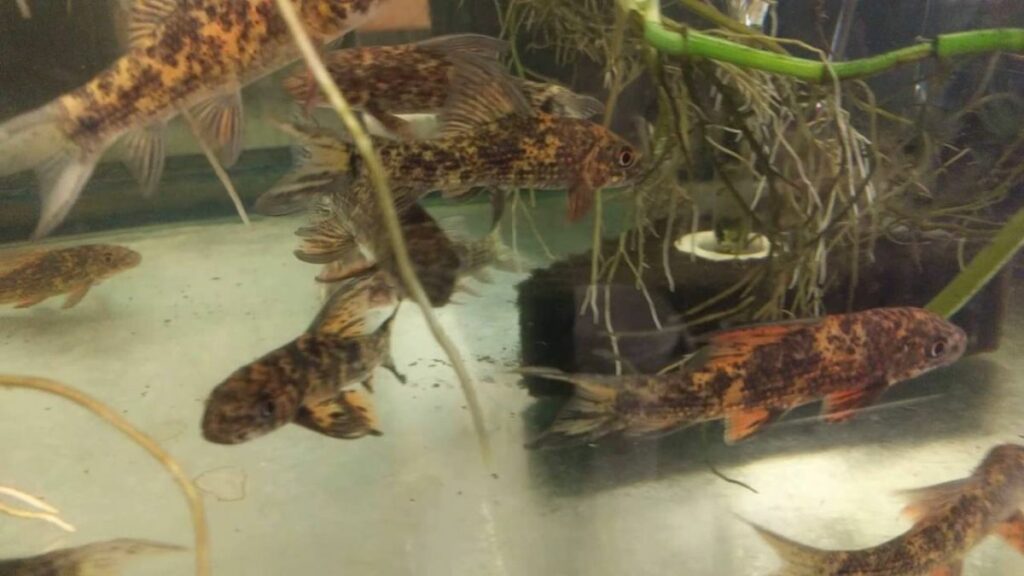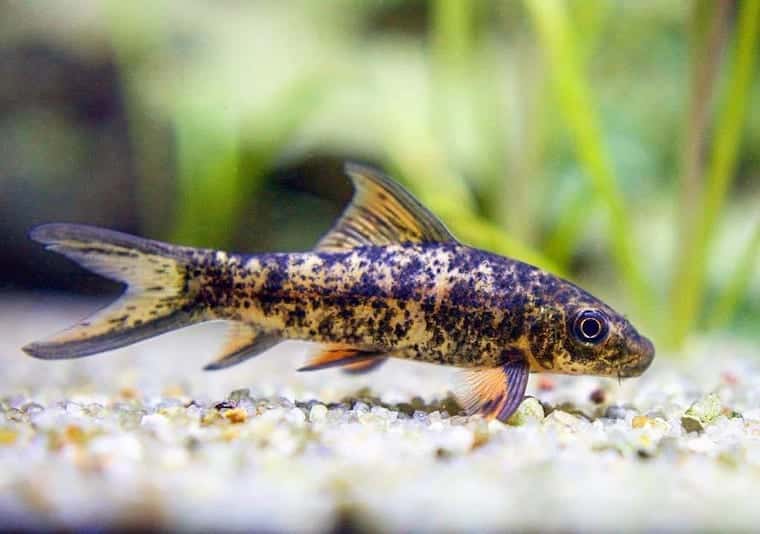The patchy, chaotic pattern of the harlequin shark is beautiful in a subdued way. They are more active than most bottom dwelling fish. And grow large enough to impress viewers. So how easy is it to care for a harlequin shark minnow?

What is the Harlequin Shark?
Once you get past African cichlids, there are not so many fish from the continent that make it into the aquarium hobby. Kribensis cichlids, Congo tetras, and bichirs are a few that you might see. But the harlequin shark is an interesting fish that deserves more attention.
Their home region is the Congo river basin. Which is one of the largest rivers in the world, in terms of total discharge. The area is covered by a lush equatorial rainforest, where heat and precipitation are constant.
The water here is low in dissolved minerals and rich in tannins from all of the decaying plant matter. Giving you clues to the sort of water conditions harlequin sharks expect.
While these fish are hardy, all of them are wild-caught. So the closer you replicate the conditions of the Congo River, the higher your chances of success will be.
Harlequin Shark vs Other Freshwater Sharks
Freshwater sharks are a mixed group of aquarium fish. They only have one thing in common: they look somewhat like sharks. A forked tail fin, a pointed dorsal fin, and an active disposition are all that’s required for the name.
Harlequin sharks are most similar to the other cyprinid “shark minnows.” These include the red tailed black shark, rainbow shark, and black shark minnow.
All of these fish have the same bottom dwelling, territorial habits. The black shark minnow and harlequin shark are both larger and more aggressive than the red tail or rainbow sharks.
Bala sharks and Chinese hi fin sharks are distant relatives of harlequin sharks and look even more like “real” sharks. But they are very different in habits and care requirements.
Bala sharks are peaceful, schooling midwater swimmers from Southeast Asia. While Chinese hi fin sharks are coldwater pond fish that grow up to 4 feet long.
That said, none of these freshwater “sharks” are related to true saltwater sharks. In fact, sharks are very distantly related to bony fish.
The cartilaginous fish group of sharks and rays split from bony fish hundreds of millions of years ago. All land-dwelling animals, including us humans, are as close to bony fish as sharks are.
- Common Name: Harlequin Shark, Harlequin Shark Minnow
- Scientific Name: Labeo cyclorhynchus
- Origin: Congo River basin
- Length: 6 to 8 inches
- Aquarium Size: 40 gallons
- Temperament: Aggressive
- Ease of Care: Easy
Harlequin Shark Care
Caring for a harlequin shark is easy to do. They are hardy fish so long as you replicate the conditions of the Congo River basin.
Harlequin Shark Size
Harlequin shark size is manageable for a shark minnow. They don’t grow larger than 8 inches, with 6 inches being more typical.
Harlequin Shark Tank Size
Aquarists often think of bottom dwellers as inactive, with few space needs. Sucker fish are one species where this is true. But the harlequin shark minnow is an active species that will use all of the bottom space provided.
Plus, they are territorial and will bite fish that spend too much time in their chosen area of the aquarium. Your tank should be at least 40 gallons in volume. To give this fish plenty of room to roam as well as a way for its tank mates to avoid the shark minnow.
Setting Up a Harlequin Shark Aquarium
One way to contain their aggression is to place decorations that appeal to a harlequin shark. They aren’t shy fish but do like caves, rocks, or driftwood tangles to retire behind and around. When it’s time to eat the harlequin shark will start patrolling the tank, looking for food.
Decorations like caves also allow all of the fish in the tank to understand where the territorial boundaries of the shark are. It won’t (usually) attack fish that avoid its chosen turf.
Tanks with no bottom decorations are where you see the most aggression in all of the shark minnow species. Since there are no borders they will claim the entire bottom of the tank as theirs. And start chasing any fish that gets too close to the substrate.
Water Conditions for Harlequin Sharks
The second key to success with harlequin shark fish is to provide it with the right water parameters. All shark minnows, including red tailed and rainbow sharks, prefer soft, acidic water conditions.
The species that are captive bred will tolerate alkaline water conditions. But harlequin sharks are all wild caught and need rainforest water parameters to thrive.
Start by lowering the pH of your water source. Tap water in most countries is alkaline (pH 7.0+) and rich in dissolved minerals (high general and carbonate hardness). If you have access to distilled or reverse osmosis water, you’ll have an easier time keeping the hardness low.
If not, you can buffer the water by adding bottled plant tannins. Slow-release tannins also come from peat moss, Indian almond leaves, and driftwood, counteracting tap water minerals.
Water temperature is also important. These are equatorial fish, so they need conditions to remain warm and steady, all year round. Temperatures of 74-82℉ are ideal for harlequin shark minnows.
If you like biotope aquariums, add some African live plants like Anubias or African water ferns (Bolbitis sp.). The harlequin shark fish will help keep the leaves of these slow-growing plants clean by grazing on algae and biofilm.
Once you have these basic parameters down, you won’t have much trouble. They are not too sensitive to ammonia, nitrite, or nitrate levels. But you should always keep levels down to avoid stress. Harlequin sharks are also not prone to any disease in particular.
Harlequin Shark Tank Mates

Tank mates are the second complication to keeping a harlequin shark. These fish are aggressive, including towards each other. Never try keeping more than one.
When you see a tank full of them in pet stores, the fins of most will be shredded. Shark minnows are solitary fish and only seek one another out during the spawning season.
Harlequin sharks will also attack fish that don’t respect their territorial boundaries. I don’t recommend keeping other bottom dwelling fish with a shark minnow. Not even algae eaters since harlequin sharks eat plenty of algae on their own.
You could try keeping medium or large cichlids with one. But there is a good chance the two fish will fight unless the tank is extra-large (75+ gallons).
Stick to fast moving midwater and surface dwelling fish. These fish inhabit a different zone of the tank from your harlequin shark minnow. And even if they visit the bottom briefly, the shark is too slow to do them any harm.
African characins like the Congo tetra (Phenacogrammus interruptus) and the African red-eye tetra (Arnoldichthys spilopterus) are ideal tank mates. They are sizable fish, for tetras, and enjoy spacious tanks 40 gallons or larger. They are also from the Congo river basin and thrive in the same soft, acidic water conditions.
Giant danios, tiger barbs, silver dollars, hatchetfish, and African butterfly fish also do well at avoiding a harlequin shark.
What Do Harlequin Sharks Eat?
Harlequin shark fish are omnivores that specialize on eating aufwuchs, the slimy film of bacteria, protists, fungi, and algae that grows on hard surfaces. Such a diet makes them excellent algae eaters for larger aquariums.
Unless you have a giant planted freshwater tank, the supply of aufwuchs will run out sooner or later. So you will have to offer supplemental feedings to your harlequin shark minnow.
They eat prepared flakes, sinking wafers, and pellets, though formulas with a higher amount of vegetable matter are more nutritious for them.
Spirulina and kelp-enhanced brands are ideal. Harlequin sharks also eat boiled vegetables like lettuce and squash. Clip small pieces into place near the bottom so the shark has easy access to them.
Also offer occasional feedings of brine shrimp, tubifex worms, and other small invertebrates for protein and fat. But the core of a harlequin shark’s diet should be vegetarian.
Conclusion
If you are lucky enough to find a harlequin shark for sale, then you’re in for an interesting fishkeeping experience. These fish are medium sized and rather aggressive. But when kept with fast moving fish that live near the surface, these uncommon freshwater sharks do well in captivity.
FAQs
Harlequin shark full size adults grow between 6 and 8 inches long. They are medium sized compared to the other species of shark minnows.
Fish-only pet stores will have harlequin sharks at times. You can also ask them if they are able to special order them through a distributor. They are not expensive but they are very uncommon. Your best option might be to try searching for a harlequin shark for sale online.
Harlequin shark fish are an aggressive species. They will attack any fish that intrudes into their chosen area of the tank. And if the territorial boundaries aren’t very clear, it may claim the entire bottom of the tank as its turf. Fast-moving fish that don’t live near the bottom are the best harlequin shark tank mates.


